

Islamic star patterns arose in the centuries after the birth of Islam, and spread quickly as Islamic rule grew outward from the Middle East to encompass western Europe, northern Africa, and southern Asia. This form of ornamentation peaked in the first half of the second millennium. The practice then tapered off as the borders of the Muslim world began to shrink. Today, historical artifacts can be found in countries from Spain to Uzbekistan, with important concentrations in Spain, Turkey, Iran, and Morocco.
There is no precise definition of an Islamic star pattern, but there are some general trends. They tend to be rigidly geometric in design, and feature star-shaped polygonal regions. They can be found carved in wood or stone, built from latticework, or assembled from baked terracotta tiles (a style known as Zellij).
Although we have a large body of historical examples to study, we don't know exactly how artisans working at the time designed their star patterns. Their methods were typically guarded as trade secrets. Thus we are left with the exciting historical puzzle of reverse engineering lost techniques, or inventing new ones altogether. We know that Islamic scholars had mastered Euclid's Elements, and so we can ascribe to them an advanced knowledge of plane geometry. Of course, we have many more mathematical tools available today than existed a thousand years ago, and we should utilize those tools in the service of ornamental design. I am interested in understanding how star patterns may have been designed in the first place, and how we can enlarge the space of designs using what we know today. I am also interested in how to render star patterns and how to manufacture them automatically from computer descriptions.
I have developed two software approaches for constructing star patterns. Both are based on first choosing a tiling of the plane called the template tiling. Each tile in the template is then associated with a motif, a small fragment of an overall design. Tiles are filled with motifs, and connected together. When the template is erased, the result is a star pattern.
The first approach, which I now call the "Najm method", makes use of an explicit understanding of the radially-symmetric motifs that appear in many star patterns. The user chooses specific radially-symmetric motifs for each regular polygon in the template tiling. The computer can then fill the remaining tiles using an "inference algorithm" to create a design consistent with the user's choices.
The second approach, which I call the "Hankin method", does away with explicit motifs and uses only the inference algorithm. In order to obtain some of the characteristic motifs (like rosettes) that are common in star patterns, the Hankin method embeds more intelligence in the template tilings. The interesting question then becomes to compute these new tilings.
More information can be found in the papers mentioned below. Here are a few star patterns produced using these methods. Click on each for a larger version.
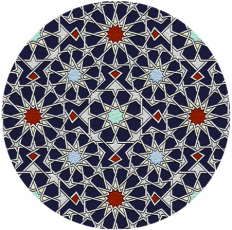
|

|
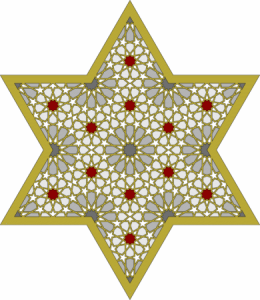
|
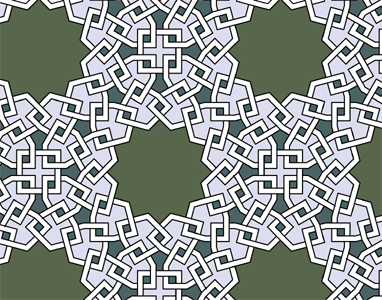
|
Once we have articulated these design techniques mathematically, we have an opportunity to do things that were either impractical or impossible with the mathematical and artistic tools of previous centuries. One long-standing possibility is to construct non-Euclidean Islamic star patterns. I have shown that we can express the construction techniques above independently of Euclid's parallel postulate, and that therefore they apply equally well to the Euclidean plane, the hyperbolic plane, and the surface of the sphere. In fact, I construct star patterns in absolute geometry, an abstract core from which the three planar geometries can be derived. By suitably encoding this geometric foundation in a C++ library, I need only write the design algorithm once.
Some examples tell the story best...

|

|

|

|

|
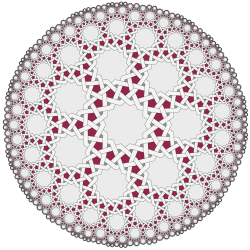
|
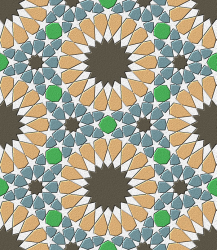
|

|
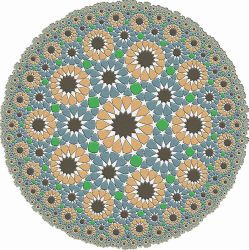
|
Parquet deformations are an abstract form of ornament first introduced by William Huff as an exercise for his Architecture students, and later popularized by Douglas Hofstadter in his Scientific American column. They are a kind of "spatial animation": a tiling of the plane from shapes that gradually evolve in space. They are the aesthetic cousins of Escher's Metamorphosis prints.
We can create Islamic parquet deformations as a simple modification of Hankin's method. Given a tiling, Hankin's method is parameterized by a single real value called the "contact angle". All we have to do is gradually change that contact angle in space. The results are striking and certainly novel: in centuries past, it would never have been practical to construct a pattern where almost every shape is unique!
Once we have software that can construct mathematical descriptions of star patterns, we can do more than simply render images of those star patterns on the computer screen. We can also feed the designs to a number of different computer-controlled manufacturing technologies. I am generally interested in how computer graphics might play a role in revitalizing the use of ornament in architecture, and star patterns are an excellent form of ornament to use as a test case. I have experimented with 3D rapid prototyping (ZCorp, FDM), laser cutting, waterjet cutting, and CNC milling and lathing. So far, there hasn't been a great deal of research necessary -- the manufacturing devices do a great job on their own. But there are opportunities for work that enhances the cooperation between designer, software, and machine.
Here are a few photographs of these experiments.
I am not actively developing my old Taprats software right now. If you want a more recent alternative to Taprats, Have a look at Pierre Baillargeon's Alhambra software.
| Craig S. Kaplan | Last updated: |